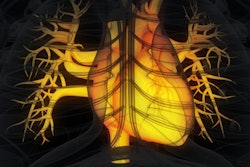
The presence of coronary artery calcium (CAC) on CT scans was associated with an increased risk of death from cardiovascular diseases, cancer, and all causes combined -- including for a subset of smokers eligible for CT lung cancer screening -- in a study published in the February issue of Atherosclerosis.
The researchers, led by Dr. Michael Blaha of Johns Hopkins School of Medicine, evaluated the capability of CT CAC scoring to predict risk of death in a population of 66,636 individuals within 10 to 13 years after initial examination. They found that individuals with high CAC scores (400 Agatston units [AU] or more) were at increased risk of death from cardiovascular diseases, cancer, and all causes, with current smokers being at the greatest risk.
"Our findings argue for consideration of coronary artery calcium scoring for risk stratification of smokers," the authors wrote. "These results may serve as evidence to use coronary artery calcium score in the lung cancer [screening] eligible population to identify higher-risk patients and initiate more aggressive preventive cardiovascular interventions."
Implications of calcium scoring
Prior research has affirmed the association between high CT CAC scores and heart disease as well as all-cause mortality, especially among smokers and other high-risk individuals.
In agreement with such studies, the American Heart Association and the American College of Cardiology have endorsed the use of CT CAC as a nontraditional risk factor for cardiovascular disease risk assessment. However, the U.S. Preventive Services Task Force (USPSTF) continues to recommend against routine clinical application of CT CAC for heart disease, citing the need for more evidence demonstrating its benefits.
For the current study, Blaha and colleagues explored possible associations between CT CAC scores and various causes of death among the U.S. CAC Consortium, which includes asymptomatic adults without known heart disease who underwent a CT exam between 1991 and 2010. The individuals underwent follow-up surveillance for a median period of 11.9 years. In all, there were 337 deaths, 102 of which were due to cardiovascular disease and 123 from cancer (Atherosclerosis, February 2020, Vol. 294, pp. 33-40).
The researchers recognized that the number of deaths increased in correlation with increasing CAC scores. A doubling of CAC score, for instance, was associated with statistically significant increases in risk of death due to coronary artery disease, other cardiovascular diseases, cancer, and all causes combined.
Honing in on the 5,147 smokers in the cohort, the researchers found that CT CAC scoring had an even stronger association with the various causes of death. Specifically, smokers with a CT CAC score of 400 AU or more had about twice the risk of dying from cancer and nearly nine times the risk of dying from coronary artery disease, compared with those who had a score of 0.
| Association between CT CAC score and cause of death in smokers | |||
| Hazard ratio | |||
| CT CAC = 1-99 AU | CT CAC = 100-399 AU | CT CAC ≥ 400 AU | |
| All-cause mortality | 1.10 | 1.40 | 2.38 |
| Cardiovascular disease mortality | 1.76 | 2.44 | 3.55 |
| Coronary artery disease mortality | 2.78 | 4.08 | 8.80 |
| Cancer mortality | 0.83 | 1.06 | 1.85 |
For smokers, the presence of CAC on their CT scans was not the only risk factor for cardiovascular disease mortality, and the absence of calcium did not necessarily translate into low mortality risk, the authors noted. They discovered that smokers with a CT CAC score of 0 still had a twofold increase in risk of death from cardiovascular disease, compared with nonsmokers who had the same score.
Benefits for CT lung screening
The researchers subsequently took a qualitative approach to analyzing CAC among the full cohort, which involved counting the number of calcified coronary vessels visible on an individual's CT data. They found that the more calcified coronary vessels individuals had on their CT scans, the greater the risk of death from coronary artery disease, all cardiovascular diseases, and all causes combined (p < 0.001).
Furthermore, Blaha and colleagues performed an analysis exclusively of the 1,149 individuals who would have met the USPSTF age and smoking history eligibility requirements for CT lung cancer screening (55 to 80 years with greater than 30 pack-years).
Among the population that would have been eligible for CT lung screening, doubling in CT CAC score was associated with statistically significant increases in risk of death from coronary artery disease (hazard ratio of 1.3) and all cardiovascular diseases (hazard ratio of 1.19). In addition, the all-cause and cancer mortality rates were two times greater for those with a CAC score of at least 400 AU than for those with a CAC score of 0. The increase in risk of death from cardiovascular diseases was more than fivefold for those with a high CAC score, compared with a low CAC score.
"The strong predictive performance of CAC testing in the lung cancer screening eligible population suggests that CAC scoring is useful for cardiovascular risk stratification in this high-risk population using available CT scan data without any further costs or radiation exposure," the authors wrote.
"The present study argues for future research on the potential utility of [CT] CAC scoring for more accurate lung cancer risk estimation," they concluded.




















